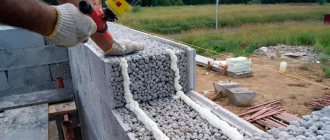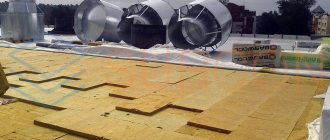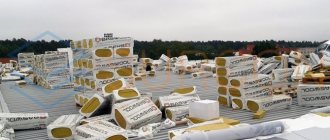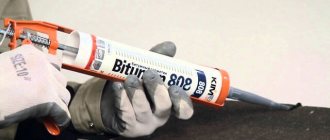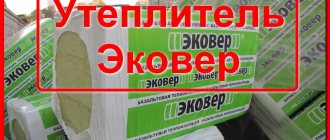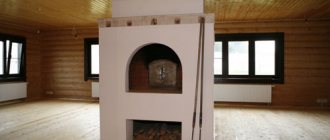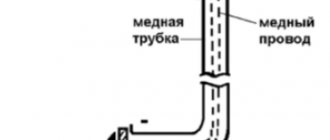What is mastic used for?
Fireproof mastic for furnaces is usually used to protect the joints of flues, furnaces and other heating units from the formation of cracks and open gaps. The main problem is that the temperature of combustion products can sometimes reach a thousand degrees Celsius, which leads to the appearance of mechanical defects.
When cracks appear, chimneys cease to cope with their main responsibility - removing combustion products, so the latter end up in the living area. Heat-resistant mastic for stoves protects against smoke in the room and an increase in the content of hazardous components and carbon monoxide. If this situation continues for a long time, serious harm can be caused to the human body.
The main area of application of fire-resistant mastic is to perform facing and other work that cannot be performed using standard adhesive mixtures. The main problem is that under the influence of high temperatures, the properties are lost, which can lead to the falling of the facing stone or the appearance of cracks. This material is often used for gluing insulating materials, however, this format of use implies unnecessarily high costs.
Application area
Fire-resistant mastics are used in the construction of various types of household heating equipment, including the installation of smoke gas exhaust ducts and shafts; for sealing industrial heat-generating and technological units, the housings of which during operation are heated to temperatures exceeding 1000℃.
Thermally intumescent fire-retardant mastics are used when constructing fire-resistant dividing belts on combustible roof coverings, as a fire-prevention cutting in places where they pass through combustible structures of floors, roofs of buildings, chimneys, shafts; as well as for coating building structures made of steel alloys that do not have the fire resistance limit required by standards.
Demonstration of fire-resistant properties
-Heat, -thermo, -fireproof - what's the difference?
In specialized stores you can find a huge amount of mastic, so some buyers are surprised by this choice. In addition to the fact that heat-resistant mastic for stoves and fireplaces is produced by various factories and companies, they also differ in name.
In recent years, many manufacturers have begun to use some marketing tactics to increase sales of their products. So, some of them indicate that specific products:
- Withstands various chemical irritants;
- Has a shorter hardening time;
- Special components or production technologies are used.
In fact, the difference between all of them is minimal, since all products are produced using the same technology. When purchasing, you should pay attention to the type of mastic: heat, thermal and fire-resistant. The main difference lies in the operating temperatures that they can withstand without cracks or other mechanical damage.
According to numerous studies, average operating temperatures are:
- For heat-resistant mastic - up to 1,600 - 1,700 degrees Celsius;
- For fire-resistant mastic – up to 1,300 degrees;
- For heat-resistant mastic - up to 1,100 degrees.
It is recommended to use only heat-resistant mastic, however, if the issue of price is quite acute, you can differentiate the working areas in order to use simpler analogues in more distant areas.
Choice of mastic
The process of choosing mastic is both complex and simple. In specialized stores you can find a huge number of offers, and consultation with specialized specialists will help you choose the right option. It is always worth remembering some features of the choice.
Criterias of choice
First of all, you need to focus on the operating temperature of the mastic. If you plan to cover the front part, then you should choose a heat-resistant option. Carefully calculate the area of different zones to reduce purchasing costs.
If the issue of price is acute for you, then you should also focus on the price, but you should not skimp on the type of mastic, as the consequences can be dire. Domestic products have a lower price and are practically no different from their foreign counterparts.
Top brands
Among the best brands available on the Russian market, products from the following manufacturers stand out:
- Terracotta (Russia) - the average price for a 2.5 kg bucket is 150 rubles.
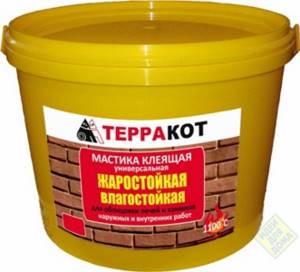
- Neomid Supercontact (Russia) – a 20 kg bucket costs about 1,300 rubles.
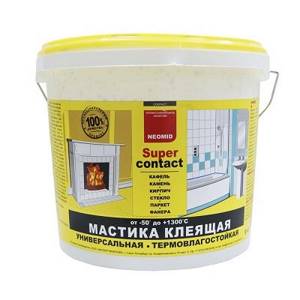
- Calorygeb (France) – produced in small quantities. The average price is 600 rubles.
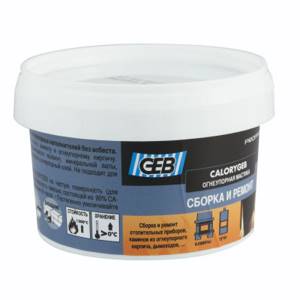
- Tytan (Poland) - an analogue of the previous option with the corresponding price and volume.
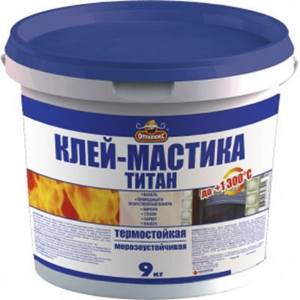
- Collafeu (France) is one of the best and most expensive options, which is characterized by excellent adhesive properties and ease of use.
Adhesive mastic, moisture-resistant, heat-resistant “Terracotta” 2.5 kg
Terracotta mastic is used for repair, finishing and restoration work, gluing facing (tiles, natural stone, thermal panels), structural (brick, block) and protective (mineral wool, expanded polystyrene) materials on heated objects (house and bath stoves, fireplaces, barbecue stoves, hot water boilers, heat-resistant bath screens, heated floors, etc.).
The heat resistance of Terracotta mastic is 1100 degrees Celsius. The product is moisture resistant and can be used in rooms with high air humidity (baths, saunas, bathrooms, showers, bathrooms, kitchens, dining rooms, etc.). The product is odorless, non-volatile, and does not require ventilation of work areas. “Terracotta” mastic is frost-resistant and can withstand negative temperatures down to -50°C without losing its adhesive properties. Mastic "Terracotta" is a reliable, durable adhesive, bactericidal and heat-resistant material. During long-term storage, the presence of a liquid phase of silicate binder on the surface of the paste is allowed.
Terracotta mastic for stoves and fireplaces is available in plastic buckets with a sealed lid with net weights ranging from 1.5 kg, 2.5 kg, 5 kg, 9 kg and 20 kg.
PREPARING THE MATERIAL FOR WORK
Mastic "Terracotta" is a ready-to-use adhesive composition. Immediately before applying the mastic to the surfaces to be glued, it must be thoroughly kneaded to a uniform consistency. If the mastic is frozen during storage or transportation, before using the material, it is necessary to uniformly warm the entire volume to a temperature not lower than +5°C
SURFACE PREPARATION
The surfaces to be bonded must be degreased and cleaned of dirt and dust. The gluing surface must be completely dry. To avoid increased consumption of mastic, unevenness and significant surface roughness must be smoothed and leveled.
PERFORMANCE OF WORK AND CONSUMPTION OF MATERIAL
Work with mastic should be carried out at an ambient temperature of at least +5°C. Complete hardening and strength gain of the adhesive joint occurs with a layer of mastic of 1 mm within 24 hours from the completion of work. It is recommended to apply the mastic evenly onto one of the surfaces to be glued using a comb (notched) spatula in a layer of 1 mm. An increase in layer thickness leads to an increase in mastic consumption. The consumption of Terracotta mastic with a layer of 1 mm is 0.8-1.3 kg per 1 square meter of the surface to be bonded.
PACKING AND STORAGE
Available in plastic buckets with a sealed lid with a net weight of 1.5 to 20 kg. Guaranteed shelf life in undamaged original packaging is 12 months from the date of production.
SPECIFICATIONS
- mastic color - gray
- specific gravity (density) 1.78 - 1.83 kg/m³
- adhesion: no less than 0.90 kg/s m²
- heat resistance: 1100°C
- volatility - not volatile
- application temperature – from +5°С to +35°С
COMPOUND
Silicate mineral binder, ground fractionated talc, marshalite and its analogues, functional premixes and additives.
| dimensions | |
| 9 Weight (kg) | 2.5 |
| additional information | |
| Maximum temperature, C | 1100 |
| 1 Country of origin of the brand | Russia |
How to make mastic for the oven with your own hands?
For some customers, the issue of price is very important, so such people do not want to spend large sums of money on the purchase of specialized mastic for finishing fireplaces. Fortunately, there are several simple and effective recipes that really help you save money. DIY mixtures can be created from:
- Clay and sand;
- Concrete mixture.
The first option is more preferable, since clay is a universal material that can easily withstand high temperatures. This recipe has been used for a long time for the construction of stoves, so there is no need to doubt its effectiveness.
To prepare mastic with your own hands, you will need clay and yellow sand of small and medium dispersion in a ratio of two to three. These materials are mixed with each other until smooth, and then water is added. The finished material should have a fairly thick consistency. If too much water is added, the adhesive properties will be reduced, which will complicate the work.
Advantages and disadvantages
Advantages:
- They are made from natural, artificial materials - non-toxic, odorless when exposed to high heat.
- They are resistant to chemical and microbiological influences.
- They withstand sudden temperature changes without cracking, ensuring a high degree of tightness of the joints and seams that are treated with them.
- Reliability and durability of applied coatings.
The disadvantages include high requirements for the preparation of protected surfaces.
Instructions for use
The use of heat-resistant mastic is a fairly simple and straightforward process that does not require special skills.
- It is recommended to perform temperatures in the range from five to forty degrees Celsius, since it is within these numbers that the maximum “setting” of the mastic is achieved. The material is supplied in the form of a dry mixture. To prepare working mastic, you need to add 300 ml of water to a kilogram of dry component.
- Before application, it is necessary to thoroughly clean the working surface from dust and dirt that may have remained at previous stages of work. For these purposes, you can use a wire brush or other analogues. There is no need to degrease the surface with acetone or solvent.
- The mastic itself is applied to the surface using a plastering tool in a thin layer, the thickness of which is about five millimeters. If there is a need to create a layer of more than 15 mm, then a metal reinforcing mesh should be used to add strength.
- It takes about 36-48 hours for the mastic to completely harden. During this time period, it is not recommended to light a fire in the fireplace, as this can lead to linear expansion of the mastic and an increase in its volume.
What is it and its purpose
Mastics are putties that are mixtures of various substances intended for gluing, reliable sealing, cementing cracks and small holes; to make products, components of building structures, and industrial equipment waterproof.
Various packaging of fire retardant mastics
Mastics are characterized by a dense consistency when ready for use, elasticity, and a high degree of adhesion to most types of building materials. They are supplied to customers both in the form of ready-made solutions and dry mixtures for preparation on site, with the addition of various solvents, most often water.
Hardening of such composite materials occurs both due to the gradual evaporation of solvents from the layer applied to the protected surface, and due to chemical reactions occurring in the mixture of components.
Non-flammable, fire-resistant mastics are a type of this type of material. They are designed to increase the fire resistance of construction projects and are used for lining and finishing work; for sealing household heating, industrial heat-generating equipment, cable penetrations in fire barriers.
Fire-resistant, fire-retardant mastics are non-flammable, viscous, plastic, non-toxic, heat-resistant masses that, when hardened, can withstand temperature changes from – 50 to 1800℃.
Demonstration of thermal insulation properties

